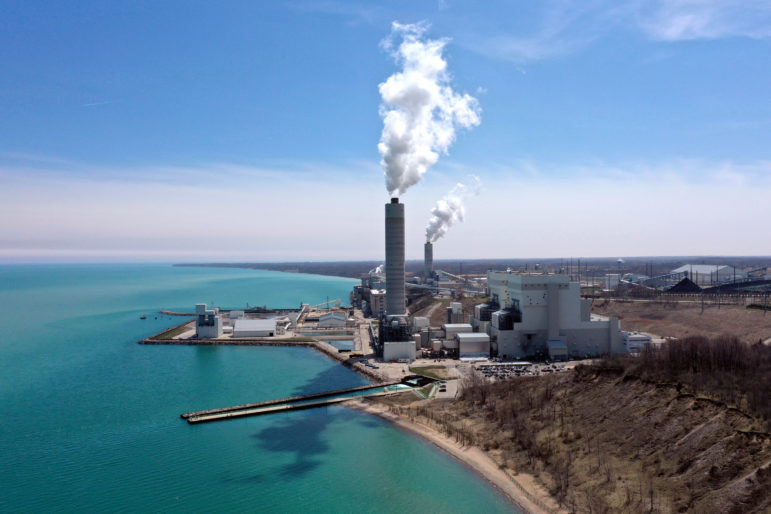EPA Proposal On Carbon Pollution Could Affect State’s Utilities
We Energies facility in Oak Creek would need to cut emissions by 90%.

The plants, in Oak Creek, Wis., near Milwaukee, are coal-fired electrical power stations. Photo by Coburn Dukehart/Wisconsin Watch.
Coal plants and natural gas facilities would have to essentially eliminate heat-trapping greenhouse gas emissions that contribute to global warming by 2040 under new carbon pollution standards proposed Thursday by President Joe Biden’s administration.
In Wisconsin, supporters say the proposal is a “game-changer,” while power providers are evaluating its effects on affordability and reliability.
The Environmental Protection Agency said the proposal would avoid releasing up to 617 million metric tons of carbon dioxide through 2042. The agency said that’s roughly the same as taking 137 million cars or roughly half the nation’s vehicles off the road. Second only to transportation, the power sector is a leading source of greenhouse gas pollution, accounting for 25 percent of all emissions.
“EPA’s proposal relies on proven, readily available technologies to limit carbon pollution and seizes the momentum already underway in the power sector to move toward a cleaner future,” EPA Administrator Michael Regan said in a statement.
Those technologies involve capturing carbon emissions from power plants and then storing them deep underground. The EPA isn’t requiring plants to use carbon capture technology. It’s costly to install and hasn’t been widely used in the power sector. Although, the agency argues costs have come down and the Inflation Reduction Act boosted a tax credit for carbon capture and storage.
Plants can either choose to cut the vast majority of their emissions through carbon capture or ramp up the use of green or clean hydrogen. But some facilities that are retiring soon or run at less than 20 percent of their capacity, such as at times of peak demand, would face less restrictive requirements.
“In Wisconsin, the power sector is the largest source of greenhouse gasses, and over 75 percent of our electricity is generated by fossil fuels,” Ciaran Gallagher, energy and air manager for Clean Wisconsin, said. “There’s just a significant amount of coal being burned in Wisconsin, so these regulations are going to have a huge impact here.”
Coal accounted for 42 percent of Wisconsin’s net electricity generation in 2021, according to most recent data from the Energy Information Administration.
Gov. Tony Evers and all five of the state’s largest electric utilities have committed to going carbon-neutral by 2050. Electric providers already plan to retire around 3,300 megawatts of power at plants by 2028, according to the state’s energy assessment. Those retirements represent almost half of the state’s seven utility-scale coal plants.
If they move forward as planned, coal would decline to 21 percent of the state’s power mix by 2028. The EPA’s proposal is intended to speed up the shift away from coal even more as part of reaching Biden’s goal to eliminate carbon emissions in the power sector by 2035.
The Wisconsin Utilities Association didn’t have any comments on the proposal Thursday. The National Rural Electric Cooperative Association said in a statement that it’s concerned the EPA’s standards would jeopardize reliability by forcing “critical” power plants into early retirement and make new gas plants harder to build.
Greg Nemet, public affairs professor and energy policy expert at the University of Wisconsin-Madison, noted there have been dramatic additions of renewable energy like wind and solar to the grid without sacrificing reliability. The nation has been on track to close half of its coal plants since 2011.
“It’s eminently feasible to have a reliable grid with less carbon emissions and less coal on that grid,” Nemet said. “I think these are arguments that 15 or 20 years ago, we would have taken seriously. And, today, there’s just too many examples of places that have moved in a big way to renewables and shutting down coal, and it’s not a problem.”
Electric providers like Dairyland Power Cooperative said they fully support investing in wind, solar, and emerging technologies. It’s exploring advanced nuclear reactors and pumped storage hydropower as part of its power mix.
Even so, Dairyland is also seeking to build a $700 million natural gas plant in Superior that would be affected under the EPA’s proposal. The agency has already said a supplemental environmental review of the plant didn’t fully analyze its effects on greenhouse gas emissions.
“Always-available resources that can ramp up in minutes to keep the lights on are also critically important,” Dairyland spokesperson Katie Thomson said in a statement. “Reliability and affordability are an increasingly important conversation during the clean energy transition as traditional plants are retired and intermittent resources take their place.”
The Edgewater coal plant in Sheboygan, the Columbia Energy Center in Columbia County and the South Oak Creek coal plant in Milwaukee County are among facilities set to be shuttered over the next three years.
Utilities who own those facilities, including Alliant Energy and We Energies, announced they were delaying closures due to fears of an energy shortage. Without further delays, the utilities would only be required to maintain routine operation as long as they commit to shutting down by 2032.
Alliant Energy said the utility is confident it’s positioned to meet the EPA’s proposed regulations for plants that are only operating in the short-term.
“At the same time, however, we recognize the importance that significant technological advancements will have on our ability to fully achieve the long-term emission reductions proposed by the EPA,” Alliant spokesperson Morgan Hawk said in a statement.
The utility said it’s reviewing how the EPA’s proposal may affect its clean energy plan that’s expected to avoid billions in costs for customers over the next three decades.
We Energies, the state’s largest electric utility, said in a statement that it will continue to focus on providing affordable, reliable and clean energy while it seeks to cut carbon emissions.
“As we move forward, we’re also working to help shape the future of clean energy — including a recent successful test to run our modern natural gas units on a hydrogen blend and our upcoming test of a green, long-duration battery,” We Energies spokesperson Brendan Conway said.
Under the EPA rule, Gallagher noted the utility’s Elm Road Generating Station in Oak Creek would be forced to cut emissions by 90 percent if it doesn’t end operations by 2040.
Supporters say rule would cut pollution, bring $85B in benefits
While the proposal would raise costs for power providers, supporters say it would drastically cut pollution and bring up to $85 billion in benefits over the next two decades. Those benefits include 1,300 fewer deaths, 300,000 fewer asthma attacks and 66,000 fewer work days lost to the effects of harmful pollution.
A 2022 analysis by Clean Wisconsin found the state ranks third worst in the country for racial disparities in exposure to harmful air pollution. It found the state’s Black residents are exposed to 41 percent more fine particle pollution than white residents.
Montre Moore, chair of the Environmental Justice and Infrastructure Initiative, said the EPA’s proposal is a step in the right direction. He noted research shows almost 10 million people die around the world each year due to pollution related to fossil fuels.
“Unfortunately, a great number of those individuals come from communities that look like me, communities that look like Milwaukee,” Moore said. “You’re talking about the asthma rates of Black and brown children. You’re talking about the prolonged health consequences of us continuously using carbon.”
Xcel Energy was the first major utility in the nation that pledged to provide 100 percent carbon-free electricity by 2050. The utility said in a statement it’s examining whether the EPA’s proposal supports its commitment to provide affordable and reliable clean energy.
“We are steadfast in our commitment to achieving a net-zero energy future while ensuring affordability and reliability,” the company said. “We will continue to work with EPA and other state and federal policymakers to ensure that this rule and all climate and energy policies meet this goal.”
Former President Barack Obama attempted to cut carbon pollution by about one third under his Clean Power Plan, but the policy was never put into place. The regulations were blocked by the U.S. Supreme Court and rolled back under former President Donald Trump.
Despite that, the EPA said the power sector has reduced carbon emissions by 36 percent since 2005 while meeting the nation’s demand for energy.
Last year, the U.S. Supreme Court reined in the EPA’s ability to regulate carbon emissions. The decision limited the EPA to controlling emissions at power plants or what’s specified under the law.
Gallagher of Clean Wisconsin said the EPA’s proposed standards will likely be challenged. U.S. Sen. Joe Manchin, D-West Virginia, has already come out in opposition to the proposal.
But, Gallagher said the regulation is similar to other rules put in place under the Clean Air Act. Since the court’s ruling, Nemet added Congress also passed the Inflation Reduction Act, which aimed to reduce the nation’s emissions roughly 40 percent by 2030.
“I think it has a really strong case — that they have the authority and the jurisdiction to do this,” Gallagher said.
Listen to the WPR report here.
The EPA proposed limits on carbon pollution at power plants. That could mean costly pollution controls. was originally published by Wisconsin Public Radio.




















